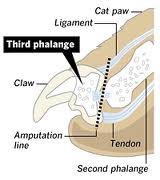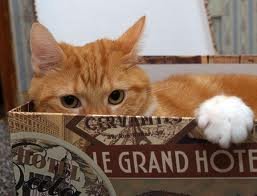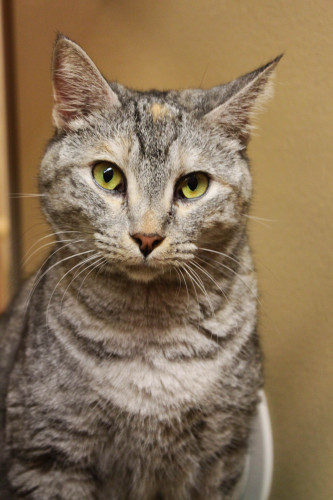Declawing Your Cat Or Not?
Declawing your cat is a questionable procedure. Some cat owners decide to declaw their cats in order to prevent them from scratching (e.g., people, other pets, and furniture).
We are against this procedure! Like many other cat owners out there, we believe that the procedure is cruel and inhumane, so before you take your cat to the Vet to be declawed, read the following.
In many countries, such as England, declawing a cat is illegal, they termed such procedure as: "inhumane" and "unnecessary mutilation."

Scratching is a natural behavior for cats. Their claws also helps to establish his footing for walking, running, climbing, stretching and defense in the outdoors.
Also keep in mind that this procedure is not recommended for cats that live outdoors since this is the cats defense mechanism against other animals.
Procedure details
This is a very serious procedure, it consists of amputation not only of the cat's claws, but the phalanx, which include bones, ligaments and tendons. The procedure involves the removal of the claw including the germinal (epithelium) cells responsible for its growth, and part or all of the third phalanx (terminal bone) of the toe.

The operation is usually performed on the front paws only. In other words, this procedure is an amputation of your cat's fingers, which is comparable to the removal of human fingertips at the first knuckle. The cat experiences pain in the recovery and healing process, which will take months to heal.
Dr. Nicholas Dodman, Professor of Behavioral Pharmacology and Director of the Behavior Clinic at Tufts University School of Veterinary Medicine and internationally known specialist in domestic animal behavioral research explains why this is an appropriate term for this operation in his book The Cat Who Cried for Help.
"Declawing fits the dictionary definition of mutilation to a tee. Words such as deform, disfigure, disjoint, and dismember all apply to this surgery."
Dr. Wolff stated that:
"Declawing is an inhumane, unnecessary procedure that has many alternatives. It is never in the cat's best interest. With declawing, we are interfering with a species' nature because of our own whims, mis-conceptions, misinformation, and sometimes, laziness." Neil Wolff, D.V.M.
What are the risks involved?
Like any surgery, this procedure is not without risk. The tourniquet, used to reduce blood loss during the surgical procedure, can harm the radial nerve, which can result in paralysis of the leg. Most of the time this paralysis is temporary, although it can be permanent.
Also, if the incisions open up, it can lead to infection and the wounds will need to be left open to heal, which would prolong the recovery and healing process.
This is a very serious procedure, and must be done by an experienced veterinarian. If the procedure is not done properly it can cause misshapen claws to grow and infection.
In addition to causing your cat pain and possible complications, some cats are also shocked by the procedure and their personality will start to change.

They may become nervous, fearful, aggressive, withdrawn and introverted. Declawed cats will often bite, since their claws are gone, their teeth are the only remaining defense mechanism they have.
Many declawed cats may also show problems while using the cat litter. They will associate the pain when digging in litter with the litter box itself, and will avoid it, choosing softer areas, such as your favorite chair, sofa, bed and carpet.
It can also lead to health issues. As we know, cats walk on their toes, by declawing a cat they will start walking with an altered gait - lack of the first digit of the toes, which in turn can affect all the joints of the leg, resulting in arthritis of the hip and other joint issues.
Again, declawing your cat is a decision that should never be taken lightly, this procedure should only take place if your cat has a medical condition that would require it, otherwise do not declaw your cat.
Help us to ban this painful and cruel procedure in the United States. Click for more details.
Finally, after considering all the facts and damage that it can cause your cat, please don't declaw your cat. Having a cat
is accepting this beautiful and loving animal as a given, he/she
depends on you. We believe that you, your family and cat can have a
healthy and joyful life together without such a cruel procedure.
Related Articles:
Why Do Cats Scratch? Behavior Issues & Solutions
Cat Training & More
Return from Declawing to Our Home Page
Healthy Cat Treat

Subscribe to Our Love Cats Digest e-zine
"A cat improves the garden wall in sunshine, and the hearth in foul weather." - Judith Merkle Riley
Marketing Strategies by









New! Comments
Have your say about what you just read! Leave me a comment in the box below.